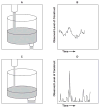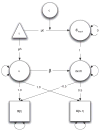Trait Stress Resistance and Dynamic Stress Dissipation on Health and Well-Being: The Reservoir Model
- PMID: 29354022
- PMCID: PMC5773058
- DOI: 10.1080/15427609.2014.906736
Trait Stress Resistance and Dynamic Stress Dissipation on Health and Well-Being: The Reservoir Model
Abstract
Daily data from the NDHWB (n = 783; age range 37-90) were analyzed to produce 'dynamic characteristic' estimates of stress input and dissipation. These were used in multi-level modeling (with age and trait stress resistance) to predict depression and health trajectories. Main effects suggest that dissipation and stress resistance predict lower depression and better health, but lower stress input was only related to lower depression. Interactions revealed that subjects with above average stress resistance had lower depression irrespective of their ability to dissipate stress, but for individuals low in trait resistance those with better stress dissipation show lower depression and better health.
Figures




References
-
- Almeida DM. Resilience and vulnerability to daily stressors assessed via diary methods. Current Directions in Psychological Science. 2005;14:64–68.
-
- Bartone PT, Ursano RJ, Wright KM, Ingraham LH. The impact of a military air disaster on the health of assistance workers: A prospective study. Journal of Nervous and Mental Disease. 1989;177(6):317–328. - PubMed
-
- Belloc NB, Breslow L, Hochstim JR. Measurement of physical health in a general populations survey. American Journal of Epidemiology. 1971;93(5):328–336. - PubMed
-
- Bergeman CS, Wallace KA. Resiliency and aging. In: Whitman T, Merluzzi T, White R, editors. Psychology and medicine. Hillsdale, NJ: Erlbaum; 1999. pp. 207–225.
-
- Block J, Kremen AM. IQ and ego-resilience: Conceptual and empirical connections and separateness. Journal of Personality and Social Psychology. 1996;70(2):349–361. - PubMed
Grants and funding
LinkOut - more resources
Full Text Sources
Other Literature Sources
